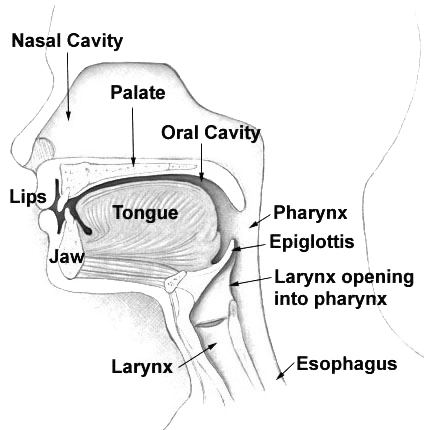 | ||
In phonetics and phonology, articulation is the movement of the tongue, lips, jaw, and other speech organs (the articulators) in order to make speech sounds.
Contents
Sound is produced simply by expelling air from the lungs. However, to vary the sound quality in a way that can be useful for speaking, two speech organs normally need to come close to each other to contact each other, so as to create an obstruction that shapes the air in a particular fashion. The point of maximum obstruction is known as the place of articulation, and the way in which the obstruction is formed and released is known as the manner of articulation. For example, when making a p sound, the two lips come together tightly, blocking the air for a little while and causing a buildup of air pressure. The lips are then released suddenly, leading to a burst of sound. The place of articulation of this sound is therefore called bilabial, and the manner is called stop (also known as a plosive).
Articulation can be shown with magnetic resonance imaging to demonstrate how the tongue, lips and jaw move and the rise and fall of the soft palate. Such movement alters resonant properties of the vocal tract, and imposes a "time-varying formant structure" onto the speech signal. The study of articulation in making speech is called articulatory phonetics.
Place of articulation
An obstruction is necessarily formed when two articulators come close together. Generally, one is moving (the active articulator), and the other is stationary (the passive articulator). As a result, what is normally termed the "place of articulation" is actually a combination of a place of active articulation and a place of passive articulation. For example, the English f sound is said to be labiodental, which is a shorthand way of saying that the active articulator is the lower lip, which moves up (along with the jaw in general) to contact the upper teeth. The lower lip can also be the active articulator for other places of articulation (e.g. bilabial, where it contacts the upper lip, as in English p). Likewise, the upper teeth can be the passive articulator for other places of articulation (e.g. dental, where the tongue contacts the upper teeth, as in the English th sound).
The places of articulation used in English are:
The place of articulation is clearest for consonants, where there is generally a significant amount of obstruction. For vowels, part of the tongue moves closer to the roof of the mouth, but there is still enough of a gap that it is difficult to precisely specify the location of maximum obstruction. As a result, vowels are normally described by height and frontness of the tongue (as well as amount of rounding of the lips) rather than by a specific place of articulation. For example, the vowel in the first syllable of father is a low back unrounded vowel; the vowel in tooth is a high back rounded vowel, and the vowel in men is a low-mid front unrounded vowel.
Sometimes there can be more than one obstruction (although rarely more than two). There are two kinds of double obstruction: Either both obstructions block the air flow in equal amounts, or one obstruction blocks the air flow more than the other. The former type, a doubly articulated consonant, does not occur in English. The latter type, however, is more common and does occur in English; w is one example. With w, the place of greatest obstruction, called the primary articulation, occurs at the soft palate; the rounding of the lips causes less blockage, and is called the secondary articulation. Another example in English is the qu of words such as quit, with the same primary and secondary articulations, but a complete blockage of the air at the soft palate rather than only a restriction of the flow (a difference in manner of articulation; see below). (Note that the sound of qu is normally analyzed as a sequence of k plus w, but both parts are actually pronounced at the same time.)
Manner of articulation
"Manner of articulation" refers in general to characteristics of the speech organs other than the location of the obstruction(s). There are multiple parameters involved here, and different types of each. The manners of articulation used in English are:
1. Degree of stricture: How much blockage occurs at the primary articulation (the place of greatest obstruction). The types in English are:
2. Alternative air flow: The air travels a path other than down the center of the mouth:
3. Dynamic movement of the tongue:
Approximants, nasals, laterals, flaps, and trills are often grouped together as sonorants or resonants (which also includes vowels); all of them have in common the fact that there is smooth airflow throughout the consonant, and they are nearly always voiced (see below).
Voicing and aspiration
Voicing: How closely the vocal cords are placed together. In English there are only two possibilities, voiced and unvoiced. Voicing is caused by the vocal cords held close by each other, so that air passing through them makes them vibrate. All normally spoken vowels are voiced, as are all other sonorants except h, as well as some of the remaining sounds (b, d, g, v, z, zh, j, and the th sound in this). All the rest are voiceless sounds, with the vocal cords held far enough apart that there is no vibration; however, there is still a certain amount of audible friction, as in the sound h. Voiceless sounds are not very prominent unless there is some turbulence, as in the stops, fricatives, and affricates; this is why sonorants in general only occur voiced. The exception is during whispering, when all sounds pronounced are voiceless.
